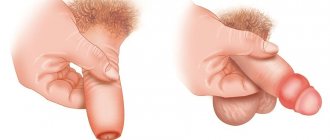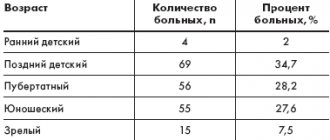Circumcision
Sexual excision protects a man from damage to the foreskin during erection and sexual intercourse, and rupture of the frenulum is avoided. Reduces the risk of sexually transmitted diseases and HIV infections.
Scientists in the USA conducted a study and published the results. It turned out that men who contracted AIDS sexually were mostly uncircumcised. After this statement, a real boom in circumcision began in America. In the 70s of the twentieth century in the USA, the operation was carried out for prophylactic purposes; about 80% of boys underwent it.
Today we offer a circumcision procedure in Moscow using anesthesia and using the latest technologies and equipment in the field of surgical urology. The cost depends on the combination of the operation and the choice of anesthesia, local or general.
Medical definition of circumcision
Phimosis - narrowing of the foreskin (prepuce) - can be pathological and physiological. Physiological is present in boys up to 2 or 3 years of age. Only in 4% of newborns the prepuce is so elastic that the head can be exposed. Until the age of seven, phimosis is not a pathology and does not require circumcision of the head.
The clinical picture of excess foreskin is different for each degree:
- the first degree is characterized by exposure of the head of the genital organ at rest; in an excited state, exposure is difficult;
- second degree - during an erection the head does not open at all, and at rest - difficulties arise;
- the third degree is manifested by not being completely exposed at rest, urination is not yet difficult, but there is a risk of tearing the foreskin during coitus;
- the fourth stage refers to the most severe, pathological form - the process of urination is difficult, urine is released in a thin stream or even drops, infection may accumulate due to the inability to carry out thorough hygienic procedures.
Doctors include the following symptoms as symptoms of paraphimosis:
- swelling;
- blue discoloration of tissues;
- pain;
- foci of necrotic tissue.
Diagnosis does not involve any difficulties, the doctor examines the genital organ, and a surgical procedure is recommended.
Rehabilitation
Complete rehabilitation after removal of the foreskin lasts no more than 2-3 weeks. On the first day, quite strong pain may be present, so taking analgesics or anti-inflammatory drugs is allowed. Swelling and small bruises usually disappear within 3-4 days, and by the end of the first week the wounds have completely healed.
To avoid infection, it is necessary to carefully observe the rules of personal hygiene. When washing and after a shower, it is important to be as careful as possible and try not to damage the seam or tear off any crusts that have formed.
You can use gels and ointments that accelerate healing. But you will have to abstain from intimate life for 2-3 weeks.
What are the reasons for circumcision?
Circumcision of the foreskin is carried out in the case of a medical opinion, as a necessary measure, or to reflect cultural or religious heritage.
Historically, circumcision of the penis was practiced by the Jewish peoples, ancient Egyptians, and adherents of the Islamic faith. With the development of surgery and population movements, this procedure was adopted by many peoples who were not accustomed to it, for some social reasons or in connection with maintaining health and hygiene.
Among Jews, according to tradition, circumcision in boys is performed after the first week of life if there are no contraindications. This ritual is prescribed in the ancient holy book of the Torah and is still practiced among almost the entire male population of Jews.
In Islam, this ritual was introduced back in the 7th century AD on the recommendations of the Prophet Muhammad and became widespread among other nations that had not previously used this method.
In some countries, prepuce trimming is performed in connection with improved hygiene, reduced risk of infection, as well as concepts of sexual seductiveness and activity.
From a medical point of view, surgical intervention is required when diagnosing:
- phimosis;
- balanoposthitis;
- premature ejaculation;
- paraphimosis;
- frequent injuries;
- genital warts.
Surgical intervention allows you to avoid serious complications, infections, and inflammatory processes, since treatment with medications, ointments, and herbs does not have any effect.
Pros of male circumcision
Nowadays, penile circumcision is performed under anesthesia, general or local, depending on the degree of the disease and the patient’s wishes. General anesthesia is recommended for children under 14 years of age.
The circumcision operation allows:
- reduce the risk of developing urinary tract infections in boys, such as cystitis, pyelonephritis;
- improve penile hygiene;
- reduce the risk of sexually transmitted diseases and HIV infection;
- prevent the risk of malignant organs of the reproductive system;
- increase the duration of sexual intercourse;
- change the appearance of the penis.
Features of preparation
In the pathological course of phimosis, the only radical (and effective) measure is surgery. The choice of circumcision method depends on several factors: the age of the patient, the type and severity of the pathology. However, the preparation for surgery is always standard:
- Blood and urine analysis.
- Fluorography, ECG.
- If the operation is performed under general anesthesia, consultation with an anesthesiologist is necessary.
In the morning before surgery, you need to wash your genitals and remove hair from the groin and pubic area.
Disadvantages of male circumcision
Deterioration after male circumcision is extremely rare and is the reason for the surgeon’s poor quality of work. It could be:
- deformation of the penis due to excessive removal of the prepuce;
- inflammatory complications;
- During the operation, the child, especially newborns, is not given anesthesia. This contributes to pain shock, which can then negatively affect overall health. In addition, after the operation it is necessary to properly observe hygienic procedures for caring for the head of the penis in a boy.
- after excision, the head of the genital organ remains constantly dry, and for sexual intercourse it will be necessary to purchase additional lubricant so as not to injure the genitals.
Risks and complications associated with circumcision
Although complications due to circumcision are rare, they can occur for a number of reasons. Here are some of the possible complications:
- pain;
- bleeding from the wound;
- bruising or swelling (swelling) of the penis – disappears spontaneously after a few days;
- infection;
- cutting off too much or too little of the foreskin of the penis – this may require another surgical procedure;
- every erection in the recovery phase is painful;
- possible change in sensations during sexual intercourse;
- irritation of the penis.
If the child has problems with urination 6-8 hours after circumcision, fever, redness of the skin of the head of the penis, progressing after 3-5 days, bleeding, then it is necessary to consult with your doctor.
Circumcision of children also raises ethical issues. Opponents of circumcision emphasize that it is an important intimate decision in which the child cannot participate.
Should you still circumcise or not?
Religious views or cultural traditions leave the right to the parents of a newborn to circumcise or not. Before the procedure, it is best to consult with specialists and undergo examinations for the risks and contraindications of surgical intervention.
There are no age restrictions, and the motive can be anything: aesthetics, religion, hygiene, aesthetics, a variety of sexual sensations. Therefore, the decision to carry out the operation is made by the person himself, making a choice whether to listen to medical indications.
In the clinic, you can perform circumcision surgery inexpensively; it is available to everyone. The referral is issued by a urologist after diagnosing the pathology or physiological characteristics of the development of the genital organ.
| Code | Our prices | Price |
| 03.23 | Circumcisio | 33,000 rub. |
Contraindications
- Hidden penis;
- Micropenis;
- Prematurity;
- Pseudohermaphroditism;
- Epispadias;
- Hypospadias;
- Anomalies in the development of the penis;
- Congenital coagulopathy;
- Hemophilia.
Author: Mamedov Rusif Bezhanovich Plastic surgeon, Candidate of Medical Sciences Received the “Grace” Award in the nomination “Best Plastic Surgeon for Facial Plastic Surgery”. Practices a unique endoscopic lifting technique, which is performed in the upper and middle zone of the face, as well as in its lower part.
Features of circumcision in men
Before the circumcision procedure, the clinic provides the patient with a choice of general anesthesia or local anesthesia. First, the length of the penis is measured in a calm state and at the time of erection. This is done so that it is clear how much soft tissue should remain so that the wound does not diverge. And in the future, for the aesthetics of the postoperative area, and the man himself did not feel any discomfort.
If you cut off more skin, it will become very tight on the penis during an erection, causing discomfort. If you don’t remove the excess, it will look ugly.
A urologist surgeon performs part or all of the circumcision procedure. Complete removal of the prepuce permanently exposes the head of the penis. Partial circumcision of the foreskin covers up to half the head of the penis.
The cut outline is outlined with a special pencil. Depending on the complexity of the operation and the degree of pathology, a scalpel, laser or electric knife can be used.
Tissues are sutured layer to layer, deep layers to deep ones, muscle to muscle, fascia to fascia, superficial layers to superficial ones. Sutures are made with special surgical threads that dissolve on their own. The fine stitching technique makes the scar almost invisible.
After surgery, the frenulum is corrected using fascioplasty, which allows you to go through rehabilitation almost painlessly.
Recovery
For 3 or 4 days after surgery, there is usually discomfort and swelling around the tip of the penis, while the surgical wound will heal completely within a month, during which it is not recommended to engage in sports or sex.
It is recommended to go to the hospital if:
- fever;
- increased redness;
- bleeding;
- constant pain;
- sensation of pulsation inside the penis.
These symptoms may indicate signs of infection.
It is generally recommended to apply petroleum jelly to the penis to prevent the operated part from sticking to the panties; Wearing light, loose clothing for 2 or 3 days after surgery will help avoid irritation.
Urination usually does not cause any discomfort.
Appearance
The appearance of the genital organ is significantly improved, because many may be embarrassed by excess foreskin. A man’s self-esteem increases, because sexual intercourse becomes longer.
Some women really like to contemplate the circumcised organ, also for hygienic reasons - increased cleanliness of the male genital organ is a definite plus.
Circumcision for medical reasons
Medical excision is considered a necessary measure when diagnosing various pathologies or physiological characteristics, when this can lead to dysfunction of the genital organ or infertility.
- Phimosis is a narrowing of the foreskin. The degree of severity may vary. Mildly does not cause physical discomfort. The most dangerous and painful is the fourth, in which it is completely impossible to expose the head of the penis and urination occurs in a very thin stream or even drop by drop. In this case, there may be a risk of purulent infections due to the accumulation of urine and the inability to carry out a thorough hygiene procedure.
- Paraphimosis is pinching of the glans penis by a ring of the foreskin. It develops as a result of complications of phimosis, as well as other diseases of the male reproductive system, which are not diagnosed and treated in time. Less often it manifests itself as a pathology of physical development.
- Condylomas are a manifestation of the human papillomavirus. This virus on the foreskin can cause cancer of the genital organ, since condylomas can be of the oncogenic type. In this case, there is a risk of causing cervical cancer in your partner.
- Premature ejaculation can occur due to increased sensitivity, because there are a lot of nerve endings on the skin of the upper flesh. After circumcision, the sensitivity of the head decreases, which prolongs the time of coitus and eliminates the problems of premature ejaculation.
- Balanoposthitis is a urological disease characterized by inflammation of the head and inner flesh. It occurs due to the accumulation of secretion of the sebaceous glands (smegma) and the presence of microorganisms from the outside.
Progress of the operation
There are two main methods of circumcision:
- Dorsal incision (from the back of the penis).
- Removing flesh using a clamp.
A dorsal incision is performed for phimosis and paraphimosis. After cutting the adhesions, clamps are applied to the foreskin (conditional positions 1 and 11 o'clock), the skin is cut off along the marked circular line, and sutures are applied. All manipulations are accompanied by coagulation of blood vessels. A sterile bandage is applied to the wound.
Healthy men who do not have phimosis undergo circumcision with clamping. As for laser circumcision, it is not popular due to the high risk of burns. The radio wave method has many more advantages. The healing rate is two times higher than after using a metal scalpel.
Stages of the procedure
Before the operation, the doctor makes a diagnosis, prescribes studies and tests. It is necessary to take a detailed blood test, the presence of HIV infection, syphilis, and blood glucose levels. With the fourth degree of phimosis, an ultrasound of the pelvic organs is prescribed. The surgeon determines whether there are any contraindications for surgical intervention, painkillers are selected, and their dosage is determined.
Circumcision for an adult takes place in several stages:
- signing a contract for surgery and anesthesia;
- shaving the operated area and disinfecting it;
- administration of local anesthesia or general anesthesia;
- the base of the penis is clamped with special clamps or a tourniquet;
- an operation is performed;
- stitches are placed.
Innovative laser techniques make the circumcision procedure more gentle and bloodless. The risk of wound infection is reduced, and neighboring areas of flesh are not affected. The frenulum is not removed during the operation.
Before and after male circumcision: loss or gain
If the process of urination causes inconvenience, discomfort occurs during sexual intercourse, constant inflammatory processes in the genital organ - then it is best to consult a specialist and undergo the procedure of excision of the foreskin. The price of circumcision depends on the type of operation and instruments.
When problems associated with the functioning of the sexual organ go away, the man gets rid of psychological discomfort.
In addition, the undoubted advantages include hygiene and reduced risk of infectious diseases.









